-
Countries
-
Data and Analysis
-
Special Focus
-
Crisis Responses
Assessment Report

Contact
NPM Bangladesh, npmbangladesh@iom.int
Language
English
Location
Bangladesh
Period Covered
Sep 01 2020
Oct 31 2021
Activity
- Survey
- Community Perception
In Cox’s Bazar, identifying and meeting the unique needs of people living with disabilities has been a challenge throughout the humanitarian response, while quantitative assessments and perception tracking have struggled to understand their diverse experiences and perspectives. In November 2021, Ground Truth Solutions (GTS) and IOM Needs and Population Monitoring (NPM) embarked on a series of qualitative interviews with persons with disabilities across Rohingya refugee and host community populations with the aim of better informing and supporting agencies in developing disability-inclusive programmes and engagement activities.
This round of research focused on access to health services, with a particular emphasis on how the perceptions and experiences of persons with disabilities have changed during the coronavirus pandemic. Through gaining insight into how people with disabilities experience engaging healthcare services – as well as perceived barriers to access, information, and resources – the humanitarian community will be better equipped to identify gaps in programming and deliver more equitable services. In line with recent findings that show 'who asks the questions' can bias responses, for the data collection IOM's NPM unit mobilised its Bangladeshi-Rohingya enumerator team, including 9 women and 8 men.
Specialised training in qualitative research skills was provided over the course of three days with technical experts from the Age and Disability Working Group (ADWG) leading targeted sessions on disability inclusive communication. Interviews were conducted with the support of ADWG partners for the identification of the interview respondents and made possible by the generous contributions of our 30 respondents, whose experiences and stories form the basis of this study. Building upon the findings of this assessment, a comprehensive analysis and report will be published in February 2022.
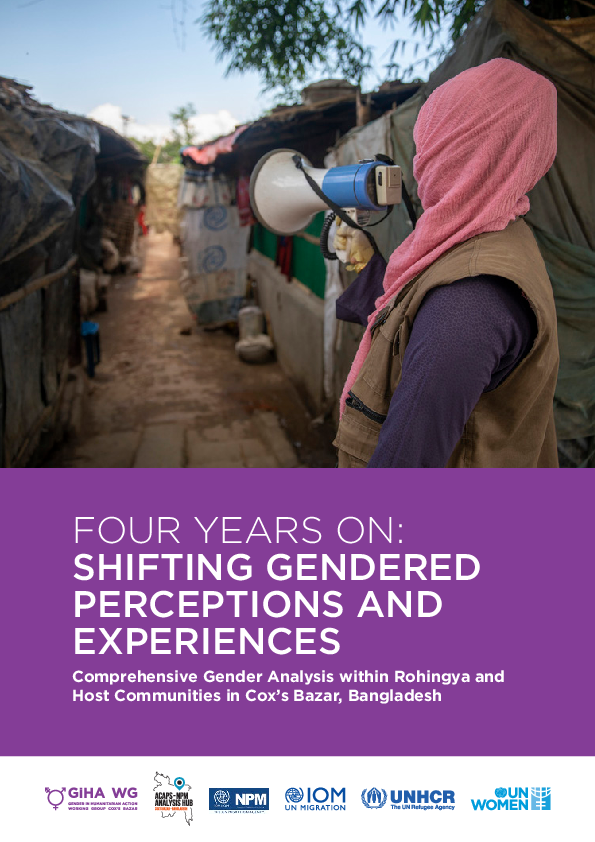
Contact
NPM Bangladesh, npmbangladesh@iom.int
Language
English
Location
Bangladesh
Period Covered
Oct 01 2020
Sep 30 2021
Activity
- Survey
- Community Perception
Gender programming as a social intervention, addressing the diverse needs of the affected population and evaluating its impacts, is complex and challenging, particularly in a humanitarian setting where urgent survival needs are prioritised. This study observed relatively meaningful and positive shifts in gender dynamics among both the Rohingya and the host community, despite the persistence of certain harmful norms and practices. We also discovered unexpected consequences of gender interventions and read subtle ambivalent feelings towards rapid change.
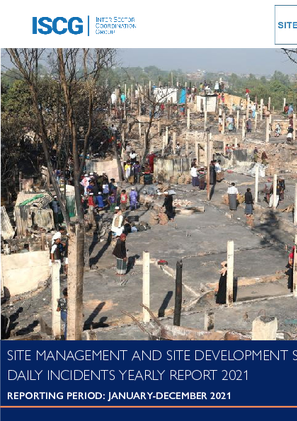
Contact
NPM Bangladesh, npmbangladesh@iom.int
Language
English
Location
Bangladesh
Period Covered
Jan 01 2021
Dec 31 2021
Activity
- Other
Introduction Following the military crackdown in August 2017 in Rakhine State, Myanmar, an estimated 700,000 Rohingya refugees fled to Cox’s Bazar district, Bangladesh. Previous influxes were recorded in October 2016, when approximately 87,000 people crossed into Bangladesh, and other waves were registered during the previous decades. The total number of Rohingya refugees in Cox’s Bazar, including those residing in the district prior to August 2017 is estimated to be 925,380 individuals .
The Rohingya refugee population is concentrated in extremely congested sites within Ukhiya and Teknaf Upazilas of Cox’s Bazar district which is well known to be vulnerable due to annual monsoon and cyclone seasons. Most of the shelters where the refugees live are made of tarpaulin sheets and bamboo in areas that are either hilly or low-lying. The combination of densely populated sites and unsustainable shelter material exposes the refugee population to serious risks associated with heavy rains and high winds, such as flooding and landslides.
The Site Management Site Development Sector (SMSD) Daily Incident Report (formerly known as the SM Category 1 Daily Incident Report) was established in May 2018 to support the Rohingya refugee response during the cyclone and monsoon season. This system was developed by the SMSD Sector in coordination with the Inter Sector Coordination Group (ISCG), IOM and UNHCR. Through this assessments, Site Management Support (SMS) Agencies systematically collect information across all camps in Cox’s Bazar affected by small-scale weather related incidents. The incidents captured through this mechanism refer to small-scale localized events (such as landslides, flood, windstorm) that cause minor to moderate damage and have little to no impact outside of the locally affected area. In case of Level 2 or 3 events2 , of larger scope, the ISCG would trigger a JNA and the SMSD Daily Incident Reporting exercise would be suspended. The purpose of the system is to track any daily incidents across all camps, and their impact on the affected population.
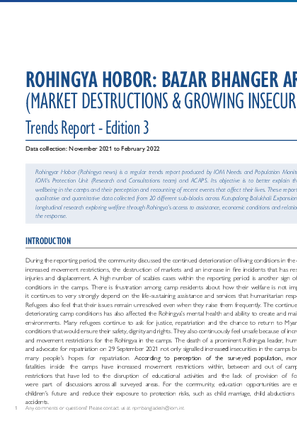
Contact
NPM Bangladesh, npmbangladesh@iom.int
Language
English
Location
Bangladesh
Period Covered
Nov 01 2021
Feb 28 2022
Activity
- Survey
- Community Perception
During the reporting period, the community discussed the continued deterioration of living conditions in the camps, including increased movement restrictions, the destruction of markets and an increase in fire incidents that has resulted in serious injuries and displacement. A high number of scabies cases within the reporting period is another sign of cramped living conditions in the camps. There is frustration among camp residents about how their welfare is not improving. Instead, it continues to very strongly depend on the life-sustaining assistance and services that humanitarian responders provide. Refugees also feel that their issues remain unresolved even when they raise them frequently. The continued perception of deteriorating camp conditions has also affected the Rohingya’s mental health and ability to create and maintain safe social environments. Many refugees continue to ask for justice, repatriation and the chance to return to Myanmar with living conditions that would ensure their safety, dignity and rights. They also continuously feel unsafe because of increasing insecurity and movement restrictions for the Rohingya in the camps. The death of a prominent Rohingya leader, human rights activist and advocate for repatriation on 29 September 2021 not only signalled increased insecurities in the camps but also shattered many people’s hopes for repatriation. According to perception of the surveyed population, more attacks with fatalities inside the camps have increased movement restrictions within, between and out of camps. Government restrictions that have led to the disruption of educational activities and the lack of provision of formal education were part of discussions across all surveyed areas. For the community, education opportunities are essential for their children’s future and reduce their exposure to protection risks, such as child marriage, child abductions and road traffic accidents.
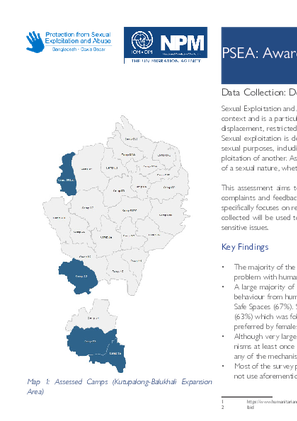
Contact
NPM Bangladesh, npmbangladesh@iom.int
Language
English
Location
Bangladesh
Period Covered
Jan 01 2021
Dec 31 2021
Activity
- Survey
- Community Perception
Sexual Exploitation and Abuse by humanitarian workers (“SEA”) can occur in any humanitarian or development context and is a particular risk in emergency contexts characterized by violence, gross power imbalance, mass displacement, restricted access, dismantled family and societal structures and gender and social inequalities. Sexual exploitation is defined as actual or attempted abuse of a position of vulnerability, power, or trust, for sexual purposes, including, but not limited to, profiting monetarily, socially or politically from the sexual exploitation of another. As another form of GBV, sexual abuse is defined as actual or threatened physical intrusion of a sexual nature, whether by force or under unequal or coercive conditions.
This assessment aims to understand Rohingya population’s knowledge and the perception of the available complaints and feedback mechanisms (CFMs) in the camps. Besides the general complaints, this assessment specifically focuses on reporting sensitive issues, especially on Sexual Exploitation and Abuse (SEA). Information collected will be used to improve existing complaint and feedback mechanisms and increase the reporting of sensitive issues.
Key Findings
• The majority of the respondents (80%) know what to do if they want to raise a complaint and/or face any problem with humanitarian assistance or services.
• A large majority of females (82%) would go to their families when they face a sensitive issue such as bad behaviour from humanitarian workers, which was followed by reporting the issue to the Women and Girls Safe Spaces (67%). Similarly, for males, family was mentioned by the highest number of male respondents (63%) which was followed by InfoHubs/ Information and Feedback Centers (47% of males) which were less preferred by females.
• Although very large majority of the respondents (88%) reported that they have used one of the mechanisms at least once for their complaints and feedback. the majority of the respondents (82%) did not use any of the mechanisms before for the reporting of sensitive issues.
• Most of the survey participants (55%) reported that non-confidentiality is the main reason why they would not use aforementioned channels for the reporting of any sensitive issues

Contact
NPM Bangladesh, npmbangladesh@iom.int
Language
English
Location
Bangladesh
Period Covered
Mar 01 2021
Nov 30 2021
Activity
- Survey
- Community Perception
In response to shelter reconstruction after the March 22nd fire in 2021, MoDMR shared an “Approval of design for construction of shelters in Rohingya camps” on April 4th (including single storey shelters and specification of the materials to be used) stating that a “single storey shelter of 10 feet x 15 feet size can be constructed for one household if construction of double storey shelter is not possible because of positional reason”. The RRRC issued a document entitled “Approval of basic principles for construction of shelter in FDMN camps” (15 April 2021) stating that “at the moment only one storied shelter will be constructed in the FDMN camps considering quick re-construction of shelters due to the massive fire incident and imminent monsoon”. The RRRC then requested the Shelter/NFI Sector and IOM to provide a design.
● The design of a shelter of 10 feet x 15 feet (150 sq. feet) was approved on April 25th, only for the reconstruction of shelters affected by the fire on March 21st
● In the submitted document, it was proposed that this shelter size (150 sq. feet) is for up to four family members (standard family size) and 1.5 shelters (225 sq. feet) can be provided for up to six family members and two shelter units1 (300 sq. feet) for seven or more family members to ensure dignified living conditions.
However, the RRRC subsequently communicated that the approved design of 150 sq. ft. is for the HHs with up to six family members and that the same design should be followed across all the camps, not only for shelters affected by the March fire. This design is currently the only approved one for single-storey mid-term shelters (MTS), and the RRRC no longer recognizes its previous MTS design approvals. To reinforce the advocacy with the government on dignified living conditions, there is a need for a comprehensive and independent survey across the camps to measure the perception of the new design and impact of the reduced size. This survey targeted 3 camps where MTS were built based on the approved design. All the responses are based on the HHs perception, no technical verification was included in this assessment.

Contact
NPM Bangladesh, npmbangladesh@iom.int
Language
English
Location
Bangladesh
Period Covered
Sep 01 2020
Oct 31 2021
Activity
- Survey
- Community Perception
At any given time, multiple assessments are underway to inform the humanitarian response in Cox’s Bazar, Bangladesh, where more than 929,000 Rohingya have sought refuge since 2017. However, data is lacking on the unique needs, preferences, and perceptions of persons with disabilities. A series of workshops with the Age and Disability Working Group (ADWG) identified the need to know how people with disabilities – both in camps and in host communities – feel about the response and their barriers to healthcare access. We hope to identify ‘blind spots’ in programming, help national and international actors deliver more equitable services, inform more inclusive performance indicators, and build trust. In November 2021, Ground Truth Solutions (GTS) and the International Organisation for Migration’s (IOM) Needs and Population Monitoring unit (NPM) conducted qualitative interviews with persons with mobility and vision impairments from Rohingya refugee and host community populations with the aim of better informing and supporting agencies in developing disability-inclusive programmes and engagement activities. In line with our findings that “who asks the questions” can bias responses, 1 NPM mobilised a Bangladeshi–Rohingya enumerator team. Three days of specialised training included input from ADWG technical experts on disability-inclusive communication. This report’s ‘user journeys’ involve seven composite personas - fictional characters derived from 33 semi-structured interviews - which help establish a narrative of people’s lived experiences. Given available resources, the nature of this approach, and the prevalence of different types of disabilities, we focused on people with mobility and vision impairments.
Key findings
• People with disabilities face significant barriers in using feedback mechanisms. They worry that providing feedback will affect them negatively, or won’t be considered.
• There is widespread confusion over aid eligibility requirements, support groups, and care options.
• Although Covid-19 messaging is widespread, dangerous rumours persist about what happens to those who seek treatment.
• Spirituality and traditional beliefs influence people’s decision-making around healthcare. This highlights the importance of religious leaders in communication.
• Costs are prohibitive and facilities lack the reasonable accommodation and supplies necessary for people with disabilities or long-term illnesses.
• Precarious terrain is a barrier to healthcare access.
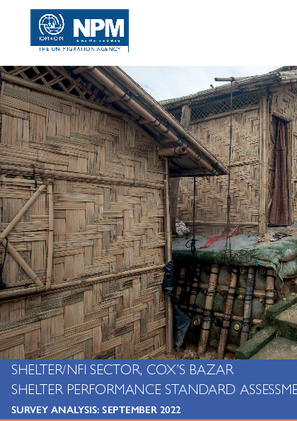
Contact
NPM Bangladesh, npmbangladesh@iom.int
Language
English
Location
Bangladesh
Period Covered
Mar 01 2021
Aug 09 2022
Activity
- Survey
- Community Perception
The total number of Rohingya refugees in Cox’s Bazar is around 936,733 individuals1 . The Rohingya refugee population is concentrated in 33 extremely congested camps within Ukhiya and Teknaf Upazilas of Cox’s Bazar district, Bangladesh. The refugees living in the camps are dependent on the assistance provided by the humanitarian community and the government of Bangladesh. Shelters are exposed to cyclic monsoons and face risk of floods, landslides, fire and cyclones. Temporary materials such as bamboo and tarpaulin have a limited capacity to resist weather impacts, and thus require regular repairs and replacement. Use of adequate material (treated bamboo, good quality tarpaulin) along with the design, site plan, proper technical details for the materials connections, can improve lifespan of materials if properly followed. Training for the beneficiaries on how to repair and maintain their shelters is also one of the essential elements of shelter assistance to ensure less dependency on humanitarian support. The below document represents findings from the joint assessment of the SNFI Sector and NPM on the Shelter Performance Standards which reflect shelters conditions across 33 camps.

Contact
DTMUkraine@iom.int
Language
English
Location
Ukraine
Period Covered
Aug 15 2023
Aug 22 2023
Activity
- Other
- Community Perception
- Mobility Tracking
To support ongoing humanitarian winterization operations, the Solid Fuel Assessment report serves to identify the heating systems used in Ukrainian households and estimate the prices of solid fuel items across Ukraine. Additionally, it examines the demand for, supply of, and pricing dynamics of essential solid fuel items both at the time of the assessment and in the upcoming month.
Data collection took place from August 15 to 22 August in all 23 oblasts. In each oblast, data was collected in at least two locations, one urban and one rural and near frontline locations, where applicable (i.e., Chernihivska, Donetska, Dnipropetrovska, Kharkivska, Khersonska, Mykolaivska, and Sumska Oblasts). In each location, a minimum of two local vendors and two community focal points (CFPs) were surveyed through face-to-face or remote interviews.
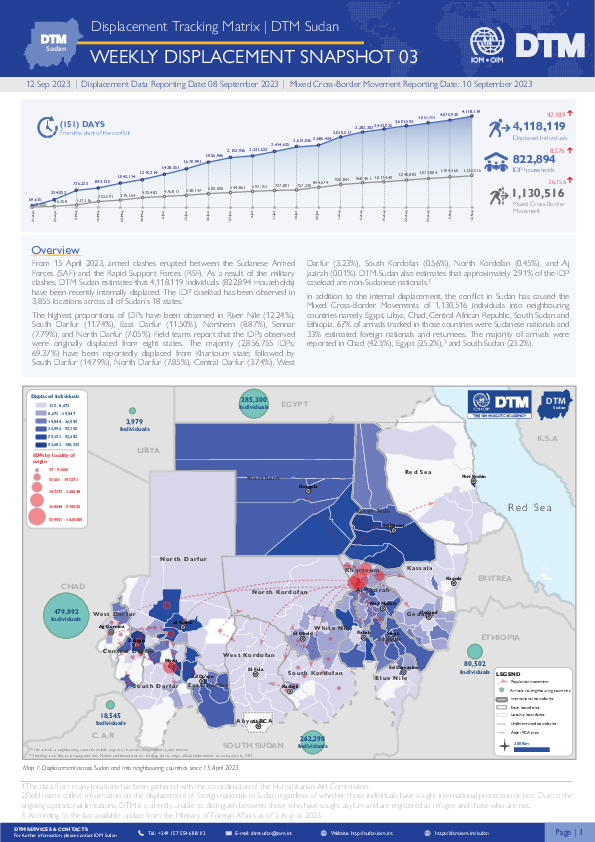
Contact
DTM Sudan, DTMSudan@iom.int
Language
English
Location
Sudan
Snapshot Date
Sep 08 2023
Activity
- Mobility Tracking
- Baseline Assessment
Overview
From 15 April 2023, armed clashes erupted between the Sudanese Armed Forces (SAF) and the Rapid Support Forces (RSF) in multiple cities across Sudan. Clashes initially took place in cities across Northern and Khartoum states, later spreading across the Darfur and Kordofan regions.
Highlights
- DTM Sudan estimates that 4,118,119 Individuals (822,894 Households) have been recently internally displaced.
- The IDP caseload has been observed in in 3,855 locations across all of Sudan’s 18 states.
- The highest proportions of IDPs have been observed in River Nile (12.24%), South Darfur (11.74%), East Darfur (11.50%), Northern (8.87%), Sennar (7.79%), and North Darfur (7.05%).
- Field teams report that the IDPs observed were originally displaced from eight states. The majority (2,856,755 IDPs, 69.37%) have been reportedly displaced from Khartoum state; followed by South Darfur (14.79%), North Darfur (7.85%), Central Darfur (3.74%), West Darfur (3.23%), South Kordofan (0.56%), North Kordofan (0.45%), and Aj Jazirah (0.01%).
- DTM also reports the Mixed Cross-Border Movements of 1,130,516 individuals into neighbouring countries.
Pagination
- Previous page
- Page 77
- Next page
